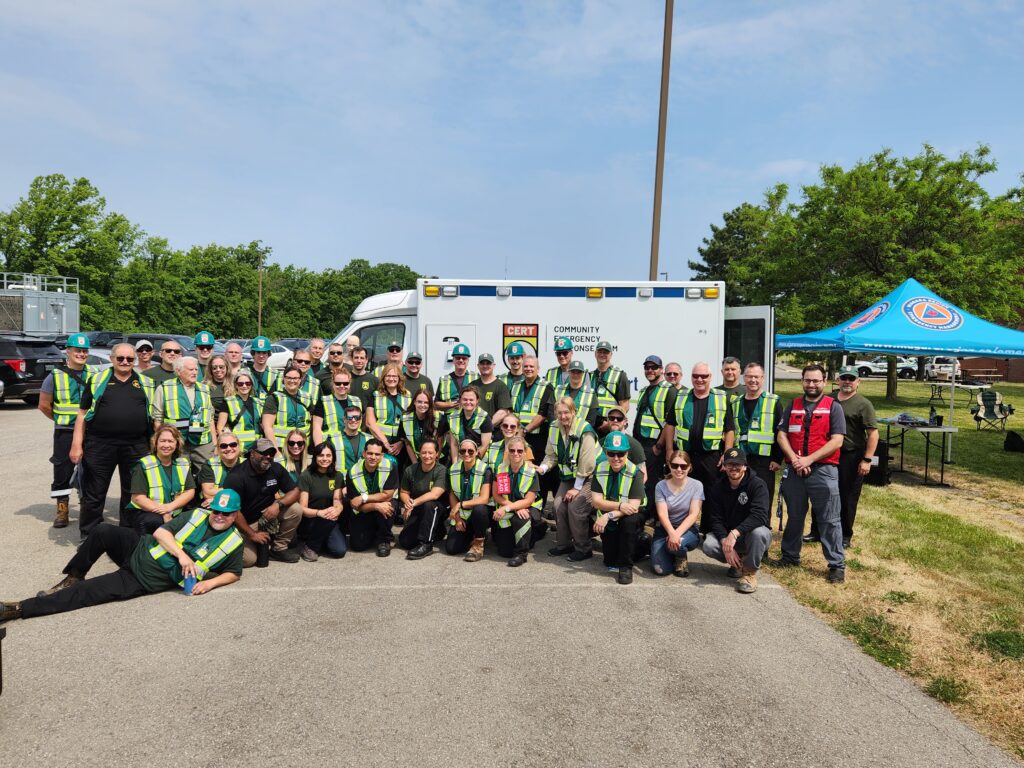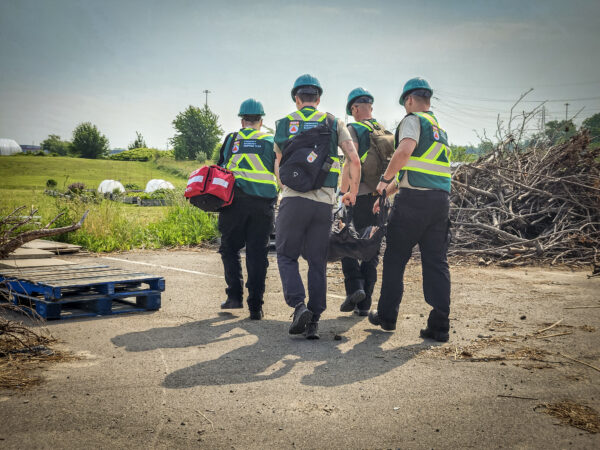
Recruit, train and equip local disaster volunteers: Southern Ontario CERT Part 1
July 24, 2023
By Grant Durfey
Niagara CERT program co-ordinator Grant Durfey explains the need for trained volunteers during local or wide-impact emergencies
 Niagara Region CERT members training. Photo provided by the author.
Niagara Region CERT members training. Photo provided by the author. Many of us as local/municipal emergency managers in Canada benefit from the bottom-up approach taken here. For most disasters, ultimate authority falls to the local emergency manager and their department or agency, and from most perspectives, this is a good system – giving the local experts with the most detailed knowledge of an area the ability to plan and act on that knowledge.
Further support is then provided to the municipality by the province and eventually, the federal government as needed. While higher levels of government are able to provide specialized resources and equipment, there is a large capabilities gap present.
Given that most authority to respond lies locally, higher levels of government in Canada generally do not maintain large operational response/surge capacities for disasters. Individual ministries and agencies do have their own specific capabilities, but quickly providing a large influx of personnel to assist locally is not what they do. And while there currently exists many great NGOs and independent organizations that can provide assistance, their capacities are limited and their operations, personnel and equipment may be spread over a wide area.
The lack of civilian disaster surge capacity in Canada is not a unique realization. Over the last few months, increasing calls have been made urging the Canadian government to drastically increase its civilian disaster response capacity. While change and improvement at all levels of government is welcome, the federal government is not the only player involved. Even though local funding is generally very limited, municipal governments and organizations can and need to start taking action to ensure their communities are as resilient and prepared as possible, building capacity truly from the bottom up, like EM doctrine in Canada calls for.

Niagara Region CERT members training. Photo provided by the author.
In lieu of a national, coordinated civilian disaster force, each local EM program is able to recruit and work with volunteers directly on its own. We know that large disasters are going to overwhelm our current workforce, and we know the surge capacity from higher levels of government is not there, so we need to start proactively embracing the use of volunteers in a disaster.
Generally, this type of volunteering can be broken down into spontaneous volunteers, colloquially known as “walk-ons,” and pre-organized volunteers.
While there are many NGOs that provide organized disaster volunteers, we are going to be focusing on those directly affiliated with an emergency management program. This may be presented as a simple answer, however there is much to consider when examining volunteer management in emergencies.
Many will advocate relying on the spontaneous volunteers who arrive after a disaster occurs, though this does come with some significant risks.
If EMs expect volunteers to come aid from elsewhere, what if the disaster is of wide impact, where many other areas are affected as well? This means volunteer forces will be more spread out and take longer to arrive.
The majority of spontaneous volunteers will have good intentions but it is unknown what training, if any, they have, the same being said for appropriate PPE and communications. These difficulties are only further compounded with the issue of command and control – how are these potentially hundreds of brand-new volunteers going to be folded effectively into operations?
Instead of the uncertainty of “walk-ons,” emergency managers need to seriously consider establishing in-house groups of pre-trained and pre-equipped disaster volunteers.
Programs such as these are by no means new and exist across the world in many different forms.
In Ontario, we even used to see a similar concept funded by the provincial government, funding which was unfortunately stopped some time ago. International models range from the German Federal THW – a very technical, specialized group – to the State Emergency Services in Australia, a predominantly volunteer group with extensive rescue responsibility and training.
While these groups operate well at a national or provincial/state level, only the largest of municipalities could sustain an organization of their size and technical requirements.
For most local emergency managers in Canada, adopting a Community Emergency Response Team (CERT) model from the United States is more affordable, realistic, and in some ways, more effective at the local level.
CERTs represent a trained group of volunteers, local to your community, designed and equipped to fit the needs and hazards your program faces. Ranging from a list of people you can call to help, to dedicated equipment and vehicles, a CERT program can be as extensive or limited as your resourcing allows.
While much can be learned from the current CERT programs south of our border, a simple copy-paste to a Canadian environment is not the best approach. Instead, EMs can conduct a gap analysis of their program or area and identify where they would need additional help, and design and train their CERT team to fill that gap.
Building a new volunteer program is not easy and many questions need to be answered, from funding and recruitment to liability and insurance.
In my next article, we will be looking at how to address these answers directly and we will examine a Canadian CERT case study to see how to successfully implement this style of program. Read Part 2, How to initiate a local EM volunteer program, here.

Grant Durfey currently works as an Emergency Management Program Specialist at the municipal/regional level in Ontario. In his day to day role, Grants portfolio covers EOC preparedness, CBRNE planning, notification system lead, and responsibility for implementing and coordinating the local Community Emergency Response Team (CERT).
Grant has extensive experience functioning both in EOCs and on-scene during emergencies and takes pride in blending this real-world experience with emerging trends and industry best practices. Grant is a strong proponent of the concept of community resiliency and believes working with the public is one of the best ways to improve disaster preparedness, planning, response and recovery.
Print this page